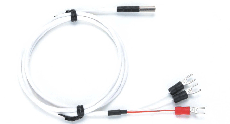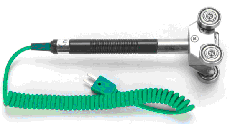- Heater
-
- Cartridge Heaters
- Tubular Heaters
- Air Finned Heaters
- Flange Immersion Heaters
- Screw Plug Immersion Heaters
- Coil Heaters
- Manifold Heaters
- Mica Band Heaters
- Ceramic Band Heaters
- Brass Nozzle Heaters
- Cast In Heaters
- Flexible Ceramic Pad Heater
- Silicone Rubber Heaters
- Ceramic Heaters
- FIR Tube Heaters(Blackbody Heaters)
- Quartz Heaters
- Heater Accessory
- Temperature Sensors
- Alloy
RTD
Resistance Temperature Detectors (RTDs) are temperature sensors that contain a resistor that changes resistance value as its temperature changes. They have been used for many years to measure temperature in laboratory and industrial processes, and have developed a reputation for accuracy, repeatability, and stability. The RTD is one of the most accurate temperature sensors. Not only does it provide good accuracy, it also provides excellent stability and repeatability. RTDs are relatively immune to electrical noise and therefore well suited for temperature measurement in industrial environments, especially around motors, generators and other high voltage equipment.
 Applications of RTD's include:
Applications of RTD's include:
- Air conditioning and refrigeration servicing
- Food Processing
- Stoves and grills
- Textile production
- Petrochemical processing
- Micro electronics
- Air, gas and liquid temperature measurement
- Exhaust gas temperature measurement
 Temperature range
Temperature range
Category |
Code |
Temperature Range |
single platinum RTD |
Pt100 |
-200 °C ~420°C |
Double platinum RTD |
||
single copper RTD |
Cu50 |
-50 °C ~100°C |
Cu100 |
 Measuring junction
Measuring junction

 Temperature tolerances
Temperature tolerances
Measurement Temperature |
Tolerance |
|||
℃ |
Class A |
Class B |
||
Ω |
℃ |
Ω |
℃ |
|
-200 |
±0.24 |
±0.55 |
±0.56 |
±1.3 |
-200 |
±0.14 |
±0.35 |
±0.32 |
±0.8 |
0 |
±0.66 |
±0.15 |
±0.12 |
±0.3 |
100 |
±0.13 |
±0.35 |
±0.30 |
±0.8 |
200 |
±0.20 |
±0.55 |
±0.48 |
±1.3 |
300 |
±0.27 |
±0.75 |
±0.64 |
±1.8 |
400 |
±0.33 |
±0.95 |
±0.79 |
±2.3 |
500 |
±0.38 |
±1.15 |
±0.93 |
±2.8 |
600 |
±0.43 |
±1.35 |
±1.06 |
±3.3 |
650 |
±0.46 |
±1.45 |
±1.13 |
±3.6 |
700 |
-- |
-- |
±1.17 |
±3.0 |
800 |
-- |
-- |
±1.28 |
|
850 |
-- |
-- |
±1.34 |
|
 products show
products show
 When inquiry, please specify:
When inquiry, please specify:
Type |
Cu50/cu100/pt100 |
level |
Class A / Class B |
Thread |
1/4 5/16 M4 M5 M6 M8 M12 fixed or flexible |
Tube Diameter |
0.5mm to 10mm |
Tube Material |
SUS304 / SUS316 |
Lead Wire |
braid /glass fiber / PVC /PTFE / Silicone |
Temperature Range |
-200℃ to 850℃ |
 Thermocouple and RTD
Thermocouple and RTD
 Hand-Held Thermocouple
Hand-Held Thermocouple

The two most common ways of measuring industrial temperatures are with resistance temperature detectors (RTDs) and thermocouples. Choice between them is usually determined by four factors. Temperature: If process temperatures are between −200 to 500 °C (−328.0 to 932 °F), an industrial RTD is the preferred option. Thermocouples have a range of −180 to 2,320 °C (−292.0 to 4,210 °F), so for temperatures above 500 °C (932 °F) they are the only contact temperature measurement device. Response time: If the process requires a very fast response to temperature changes—fractions of a second as opposed to seconds (e.g. 2.5 to 10 s)—then a thermocouple is the best choice. Time response is measured by immersing the sensor in water moving at 1 m/s (3 ft/s) with a 63.2% step change. Size: Class A RTD sheath is 3.175 to 6.35 mm (0.1250 to 0.250 in) in diameter; sheath diameters for thermocouples can be less than 1.6 mm (0.063 in). Accuracy and stability requirements: If a tolerance of 2 °C is acceptable and the highest level of repeatability is not required, a thermocouple will serve. RTDs are capable of higher accuracy and can maintain stability for many years, while thermocouples can drift within the first few hours of use.

-
THERMOCOUPLE & RTD WIRE
Insulation material: fiberglass, PTFE, PVC, silicone Thermocouple Type: K,J,T,E,,N,R,S,B RTD Type: Cu50,Cu100,Pt100 Size: from AWG 8 to AWG 40

-
THERMOCOUPLE & RTD CONNECTOR
Used for thermocouple and RTD circuits.

-
THERMOCOUPLE & RTD HEAD
Body Material: Aluminum,SS304,SS316 Material of terminal block: ceramic or Bakelite Form of terminal block:2P,3P,4P,6P






































